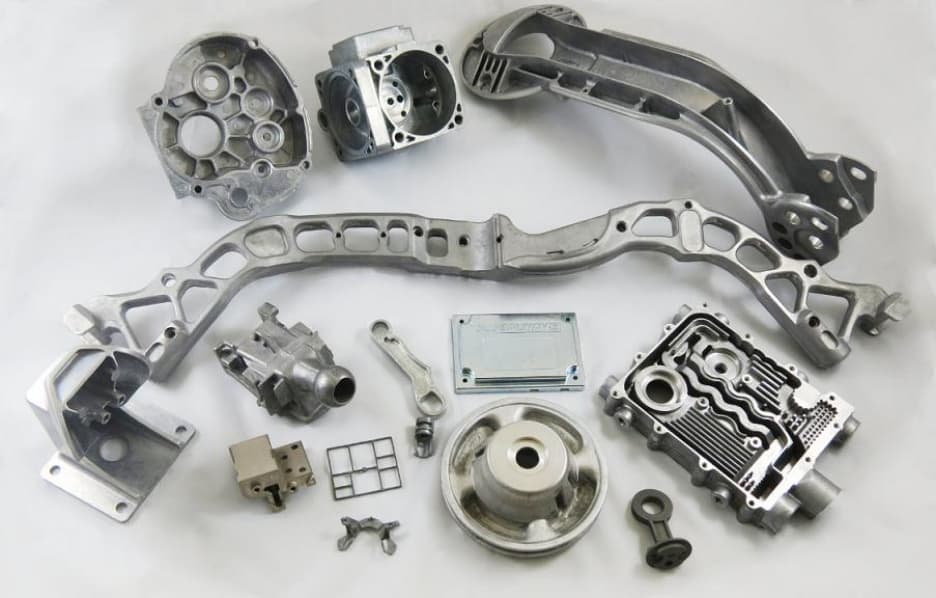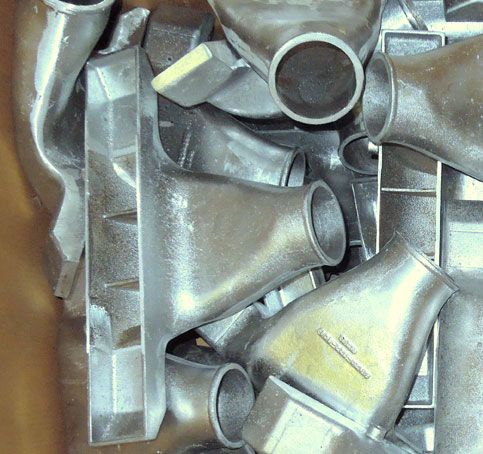How Metal Castings support innovation in different industries
Wiki Article
Exploring the Versatile Makes Use Of and Applications of Light Weight Aluminum Castings in Modern Industries
Aluminum castings have actually come to be essential to numerous modern industries as a result of their unique buildings. They supply considerable advantages in weight decrease, thermal conductivity, and rust resistance. From automotive developments to applications in durable goods and building and construction, their convenience is exceptional. Yet, real level of their impact expands beyond instant benefits, meaning broader effects for sustainability and performance. What lies in advance for aluminum spreadings in an ever-evolving industrial landscape?Automotive Industry Innovations
The vehicle industry has actually progressively accepted aluminum castings to improve lorry performance and efficiency. By making use of light weight aluminum, makers can create lighter elements, which contribute to boosted gas economy and reduced discharges. Trick applications include engine blocks, transmission situations, and architectural parts, where the material's strength-to-weight proportion supplies resilience without including excess weight.Aluminum spreadings also provide remarkable thermal conductivity, which assists in far better warmth dissipation, consequently boosting engine efficiency. Improvements in casting innovations, such as die casting and sand casting, enable the manufacturing of complicated geometries, enabling for innovative styles that maximize space and functionality.
The recyclability of light weight aluminum straightens with sustainability goals in the auto market, promoting ecologically friendly techniques. As the sector remains to innovate, using light weight aluminum spreadings is likely to broaden, driving more advancements in lorry style and performance.
Aerospace Innovations and applications
While the aerospace sector proceeds to prioritize weight decrease and gas efficiency, light weight aluminum spreadings have actually become an important product selection for various applications. Their lightweight nature, paired with high strength-to-weight ratios, enables for substantial renovations in airplane efficiency and performance. Aluminum castings are frequently utilized in architectural elements, such as fuselage frames and wing components, where lowering weight is essential.Recent advancements in light weight aluminum casting technologies, including boosted alloy formulations and accuracy spreading methods, have actually further enhanced the product's efficiency capacities. These innovations enable the manufacturing of complex geometries and complex layouts while maintaining architectural integrity. In addition, aluminum's outstanding corrosion resistance assurances long life and integrity in rough aerospace environments.
As the aerospace market progressively welcomes sustainability, light weight aluminum castings supply a recyclable option that aligns with environmentally friendly techniques, making them a pivotal element in the development of next-generation airplane.
Durable Goods and Everyday Products
As customers progressively look for light-weight yet long lasting products for everyday products, aluminum spreadings have gotten popularity in different durable goods. The unique homes of light weight aluminum, including its resistance to rust and excellent thermal conductivity, make it an excellent selection for things like pots and pans, house devices, and outside equipment. Aluminum cast pots and frying pans provide even warm circulation, enhancing cooking efficiency. Furthermore, using light weight aluminum in items such as bike structures and luggage ensures a balance in between toughness and portability. Makers appreciate light weight aluminum castings for their versatility, as they can be quickly formed into complicated shapes while preserving architectural integrity. The ability to recycle aluminum without weakening its residential properties aligns with expanding customer preferences for sustainable items. In general, light weight aluminum castings are integral to the production of sturdy, practical, and visually pleasing consumer items, meeting the needs of contemporary way of livings.Construction and Architectural Utilizes
Aluminum castings have ended up being an essential part in building and construction and architectural design, particularly because of their toughness and light-weight nature. These residential or commercial properties make aluminum an excellent option for numerous applications, consisting of structural components, exteriors, and ornamental attributes - Wisconsin Aluminum Foundry. Building contractors and designers progressively make use of light weight aluminum spreadings for home window frames, doors, and roof, boosting both functionality and visual appeals. The product's resistance to rust better prolongs its life-span, decreasing maintenance expenses and ensuring durability in diverse environmental problemsLight weight aluminum can be conveniently molded into complex layouts, permitting for cutting-edge building expressions. Its convenience promotes the creation of custom items that fulfill specific style needs, from luxuriant barriers to complicated assistances. As sustainability ends up being a concern, light weight aluminum's recyclability contributes to its charm in environment-friendly construction techniques. Generally, light weight aluminum castings are revolutionizing the building industry by giving light-weight, long lasting, and aesthetically enticing options.
Digital and electrical Elements
Light weight aluminum spreadings play an important duty in the production of lightweight electrical enclosures, which boost portability and efficiency in different applications. In enhancement, their outstanding thermal conductivity makes them perfect for warm sinks, making sure peak efficiency and longevity of electronic components. Moreover, aluminum's conductive residential or commercial properties add to its usage in various electrical conductors, emphasizing its importance in modern-day innovation.Lightweight Electrical Rooms
Light-weight electrical rooms play a crucial function in securing delicate digital components from environmental aspects and physical damages. Constructed from light weight aluminum spreadings, these units are valued for their strength-to-weight ratio, making them optimal for numerous applications across industries. Their lightweight nature help in minimizing overall system weight, which is essential in mobile and mobile electronics. Moreover, light weight aluminum's deterioration resistance boosts toughness, expanding the life expectancy of the enclosed elements. The capability to mold light weight aluminum right into complex shapes enables tailored layouts, accommodating particular needs while making certain efficient heat dissipation. Furthermore, these units can be easily integrated into existing systems, giving versatility and versatility in modern technical environments. On the whole, lightweight aluminum units substantially add to the efficiency of digital devices.Heat Sinks and Conductors
While numerous products are used in digital elements, aluminum castings attract attention for their performance in heat management as heat sinks and conductors. Their outstanding thermal conductivity allows for efficient warm dissipation, which is important in stopping the getting too hot of electronic gadgets. Light weight aluminum's light-weight nature additionally boosts its suitability for applications where weight is a considerable variable, such as in aerospace and auto sectors. In addition, aluminum castings can be quickly built right into complex forms, offering design versatility for optimizing thermal efficiency. The corrosion resistance of aluminum additionally adds to the long life and integrity of these elements in different environments. As technology developments and tools become a lot more compact, the need for reliable warmth monitoring solutions, like aluminum castings, proceeds to expand.Marine Industry Utilization
The marine sector significantly depends on aluminum spreadings for their outstanding toughness and rust resistance. These homes make light weight aluminum a suitable choice for numerous applications, consisting of watercraft hulls, engine elements, and aquatic hardware. The light-weight nature of light weight aluminum castings makes it possible for enhanced gas effectiveness and simpler ability to move in boat, which is necessary for both business and entertainment vessels.
Aluminum spreadings additionally supply significant cost advantages due to their long life-span and reduced upkeep demands, lowering the overall functional expenditures for marine drivers. Additionally, the versatility of light weight aluminum enables elaborate designs that can meet specific performance requirements.
Makers in the marine industry use innovative spreading methods to generate complex forms, guaranteeing that components fulfill extensive security and efficiency requirements. As the need for high-performance marine vessels expands, light weight aluminum castings are positioned as a vital material in boosting the functionality and durability of aquatic equipment.
Sustainability and Recycling in Light Weight Aluminum Spreading

Light Weight Aluminum Recycling Process
Reusing light weight aluminum plays a necessary role in lessening ecological impact and saving sources within the casting sector. The aluminum reusing process begins with the collection of scrap light weight aluminum, which can include old components, producing waste, and post-consumer items. This scrap is then arranged, cleaned, and shredded into little items to facilitate melting.When prepared, the light weight aluminum scrap is thawed in a furnace at lower temperature levels than key aluminum production, considerably reducing energy usage. The liquified light weight aluminum is after that cast into ingots or other shapes for reuse in different applications - Aluminum Foundry. This closed-loop system enables the efficient healing of aluminum, protecting its properties while decreasing the need for virgin products. The recycling process is a vital part of sustainable practices in aluminum spreading.
Ecological Advantages
While aluminum spreading plays a crucial role in various industries, its ecological advantages are specifically impressive regarding sustainability and resource conservation. The lightweight nature of aluminum contributes to power effectiveness in transport, minimizing fuel consumption and emissions. In addition, light weight aluminum spreading assists in the use of recycled materials, significantly lowering the power needed for production compared to key light weight aluminum. This recycling procedure decreases waste and minimizes the you could look here environmental impact related to mining and refining basic materials. Additionally, aluminum is 100% recyclable without destruction of its properties, advertising a sustainable lifecycle. By selecting light weight aluminum spreading, industries can substantially decrease their carbon impact while advertising resource efficiency, making it a necessary option in the search of eco-friendly production methods.Closed-Loop Systems

Regularly Asked Concerns
What Are the Secret Benefits of Light Weight Aluminum Castings Over Other Products?
Light weight aluminum castings provide light-weight residential or commercial properties, superb corrosion resistance, and high strength-to-weight ratios. They can be quickly built right into complex shapes, offer great thermal and electric Your Domain Name conductivity, and are cost-efficient, making them more effective over several different materials.How Is the Aluminum Casting Process Eco-friendly?
The light weight aluminum spreading procedure is eco pleasant as a result of its recyclability, reduced power Check This Out intake, and reduced waste production. Its capability to use recycled products lessens the carbon impact, advertising sustainability within producing methods.What Are Typical Difficulties in Light Weight Aluminum Casting Production?
Usual challenges in aluminum spreading manufacturing consist of preserving dimensional accuracy, managing thermal contraction, preventing defects like porosity and incorporations, ensuring proper mold and mildew layout, and enhancing production efficiency while minimizing product waste and ecological effect.How Do Light Weight Aluminum Castings Compare in Cost With Various Other Production Methods?
Light weight aluminum castings usually provide competitive prices contrasted to various other making techniques, particularly for medium to high-volume production. Their lower initial tooling expenditures and efficient product usage can lead to beneficial economics with time.What Future Patterns Are Expected in Light Weight Aluminum Casting Technology?
Future patterns in aluminum spreading technology are prepared for to include advancements in automation, boosted alloy make-ups, improved recycling techniques, and the integration of 3D printing, all intended at enhancing performance, decreasing prices, and reducing ecological effect.Current advancements in aluminum spreading technologies, including boosted alloy solutions and accuracy spreading methods, have actually even more boosted the material's performance capacities. Aluminum castings have come to be a vital part in construction and architectural layout, particularly due to their stamina and light-weight nature. The light weight aluminum recycling process begins with the collection of scrap light weight aluminum, which can consist of old components, producing waste, and post-consumer items. As soon as prepared, the aluminum scrap is melted in a heating system at reduced temperature levels than key aluminum manufacturing, greatly minimizing power intake. In addition, aluminum casting helps with the use of recycled products, substantially reducing the power required for production compared to primary aluminum.
Report this wiki page